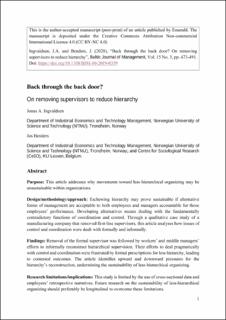| dc.contributor.author | Ingvaldsen, Jonas A | |
| dc.contributor.author | Benders, Josephus Gerardus Johannes Mar | |
| dc.date.accessioned | 2020-09-14T13:31:18Z | |
| dc.date.available | 2020-09-14T13:31:18Z | |
| dc.date.created | 2020-06-08T14:28:42Z | |
| dc.date.issued | 2020 | |
| dc.identifier.citation | Baltic Journal of Management. 2020, 15 (3), 473-491. | en_US |
| dc.identifier.issn | 1746-5265 | |
| dc.identifier.uri | https://hdl.handle.net/11250/2677746 | |
| dc.description.abstract | Purpose
This article addresses why movements towards less-hierarchical organizing may be unsustainable within organizations.
Design/methodology/approach
Eschewing hierarchy may prove sustainable if alternative forms of management are acceptable to both employees and managers accountable for those employees’ performance. Developing alternatives means dealing with the fundamentally contradictory functions of coordination and control. Through a qualitative case study of a manufacturing company that removed first-line supervisors, this article analyses how issues of control and coordination were dealt with formally and informally.
Findings
Removal of the formal supervisor was followed by workers’ and middle managers’ efforts to informally reconstruct hierarchical supervision. Their efforts to deal pragmatically with control and coordination were frustrated by formal prescriptions for less hierarchy, leading to contested outcomes. The article identifies upward and downward pressures for the hierarchy’s reconstruction, undermining the sustainability of less-hierarchical organizing.
Research limitations/implications
This study is limited by the use of cross-sectional data and employees’ retrospective narratives. Future research on the sustainability of less-hierarchical organizing should preferably be longitudinal to overcome these limitations.
Practical implications
Unless organizational changes towards less hierarchy engage with issues of managerial control and upward accountability, they are likely to induce pressures for hierarchy’s reconstruction.
Originality/value
The article offers an original approach to the classical problem of eschewing hierarchy in organizations. The approach allows us to explore the interrelated challenges facing such restructuring, some of which are currently unacknowledged or underestimated within the literature. | en_US |
| dc.language.iso | eng | en_US |
| dc.publisher | Emerald | en_US |
| dc.title | Back through the back door? On removing supervisors to reduce hierarchy | en_US |
| dc.type | Peer reviewed | en_US |
| dc.type | Journal article | en_US |
| dc.description.version | acceptedVersion | en_US |
| dc.source.pagenumber | 473-491 | en_US |
| dc.source.volume | 15 | en_US |
| dc.source.journal | Baltic Journal of Management | en_US |
| dc.source.issue | 3 | en_US |
| dc.identifier.doi | 10.1108/BJM-10-2019-0359 | |
| dc.identifier.cristin | 1814395 | |
| dc.description.localcode | © 2020. This is the authors' accepted and refereed manuscript to the article. The final authenticated version is available online at: http://dx.doi.org/10.1108/BJM-10-2019-0359 | en_US |
| cristin.ispublished | true | |
| cristin.fulltext | postprint | |
| cristin.qualitycode | 1 | |
